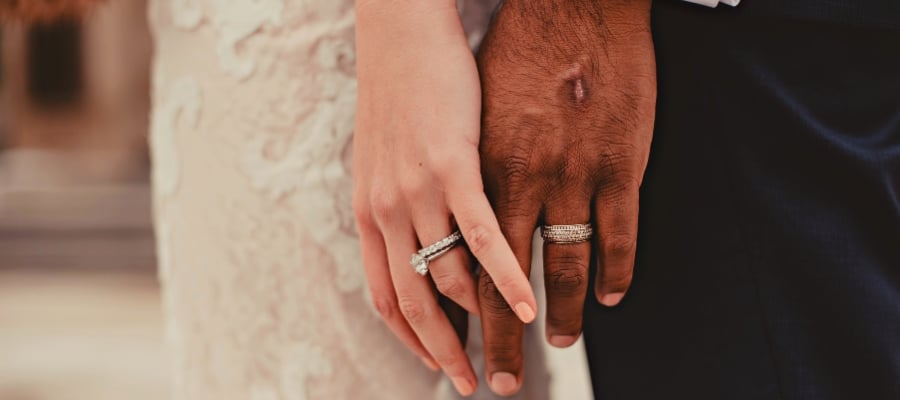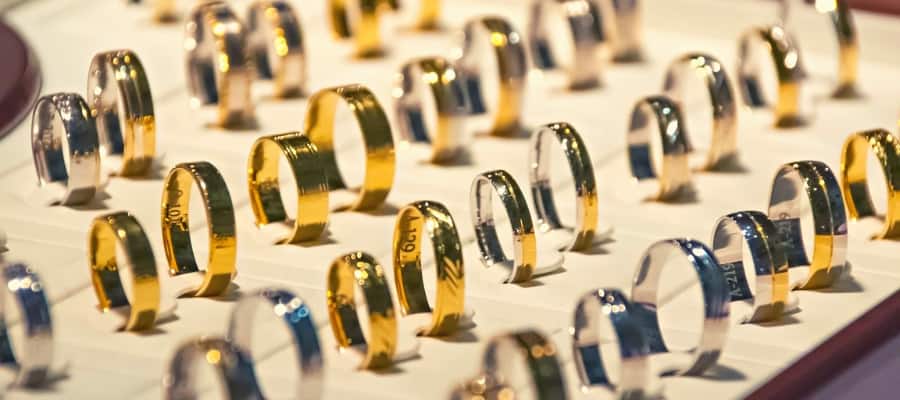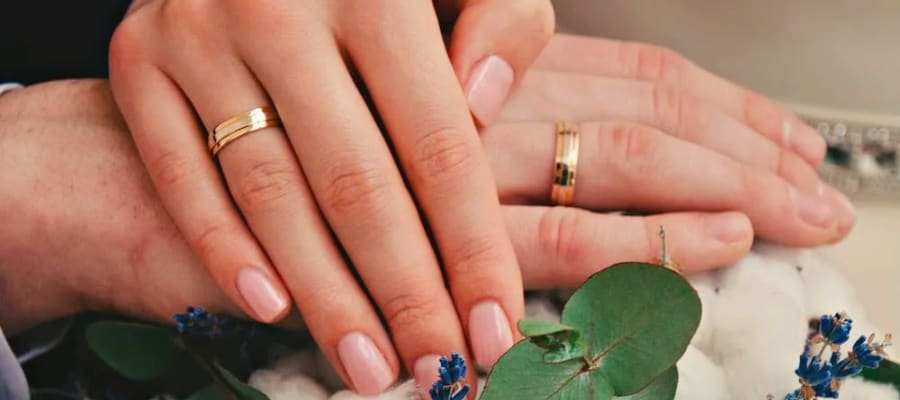Both engagement and wedding rings are symbols of commitment and love. However, if you go window shopping, you’ll realize that engagement rings cost a few thousand dollars more than wedding bands. What causes the price disparity?
Engagement rings are more expensive than bands because they are usually made with more precious metals and gemstones than wedding bands. Also, engagement rings often have a more intricate design that can feature personal style, unlike wedding bands.
In this article, I’ll break down the nine reasons why engagement rings are more pricey than wedding bands. I’ll also explore the ideal amount you should spend on both rings. Let’s dive in.
9 Reasons Why Engagement Rings Cost More Than Bands

Throughout history, people have used engagement and wedding rings to convey different meanings. An engagement ring precedes a wedding ring and signifies a promise of a future marriage. On the other hand, a wedding ring symbolizes a lifelong commitment. Although the two rings are equally important, engagement rings are more expensive for the following reasons:
1. Engagement Rings Are Adorned With Large Gemstones
If you want to stick to engagement traditions that have existed for centuries, the typical engagement ring you choose should have a gemstone at the center. A gem gives the ring color and brilliance and can still convey a symbolic meaning.
Gemstones are expensive because of their natural formation and properties. Also, most are rare, and their market demand exceeds supply, causing their prices to hike. Some of the gemstones used in engagement rings include:
- Diamonds: Diamond engagement rings became popular in the 1940s due to a clever marketing strategy by the De Beers company that convinced people diamonds are forever. This gives diamond rings sentimental value, and it is a market norm that diamonds should be expensive. The brilliance and spark in the diamond ring represent purity, fidelity, and endurance.
- Emerald: This gem occurs in different green hues and has been dominant in most royal families. It symbolizes love and faithfulness.
- Sapphire: It is the second most popular gemstone and represents faithfulness and sincerity. Though it ranges in various colors, blue sapphire is the most common color in engagement rings.
- Ruby: This is one of the hardest gemstones in a vibrant deep red color with enough transparency to reflect light. It represents passion, love, and eternity.
In contrast, wedding bands feature a simpler design made of sturdy gold, silver, platinum, or titanium. Though they do not feature large gemstones at the center, some can have small gems around the band—the smaller the gem, the less expensive the ring.
2. Engagement Rings Have More Intricate Designs
Engagement rings are about making a statement and getting a show-stopping look that is bolder, brighter, and bigger. Unlike traditional rings, which had fewer details, technology has made it possible for manufacturers to add more details on the setting and appearance of the stone.
Some intricate engagement ring styles for showcasing the gemstone include:
- Prongs: This style involves using metal to mount the gemstone securely while allowing light to flood the gemstone for a dazzling sparkle. Most engagement rings typically have four or six prongs, but jewelers can customize them to meet your needs. The various prong finishes include claws, V-tip prongs, double prongs, tab prongs, and round prongs.
- Tension: In this style, the gemstone rests in an opening in the ring setting and appears floating in the air, unlike in prongs where metals hold the gem. The lack of obstructions allows the gemstone to radiate while giving an intriguing appearance.
- Bezel: This is a popular choice for engagement rings because it provides maximum security by utilizing a thin metal rim to mount the gemstone on the setting. The design can feature intricate designs such as half-bezel, beaded, and vine-like patterns.
Conversely, wedding bands have a smaller accent and less sophisticated designs. Because of the intricate design, engagement rings require more skilled craftsmanship, time, and advanced tools and materials, costing more.
3. Deep Meaning Attached to Engagement Rings
Although engagement rings can be made from other gems, most people prefer diamond rings. Before the 1940s, people gave engagement rings but not diamond ones. Diamonds were rare, and only the wealthy could afford them. According to BBC, only 10% of engagement rings consisted of diamonds.
In the late 1940s, diamond supply increased in the market, and the manufacturer had to find a way to convince people to buy diamonds. They coined the term “diamonds are forever” to convince people that their investment would last for ages. Also, rings are round and have no beginning or end. Therefore, diamond engagement rings are a symbol of eternity.
When you slip an engagement ring on your finger, you’re telling the world that you’re taken and that this person is worth committing to. Because of that emotional connection, people are willing to pay more for them.
Some people pass diamond engagement rings from one generation to another to show the sentimental value it holds in the family.
4. The Carat of Engagement Rings Is More Than That of Bands
Carat refers to the weight of a gemstone. It is directly proportional to the price of the ring. The heavier the gem in a ring setting, the more expensive it is. Because engagement rings feature a large accent, they carry a heavier gemstone than wedding bands which can have a smaller or a non-existent center.
An average engagement ring consists of 1.5 to 1.9 carats. However, this is not the only price-determining factor. If the gemstone’s color, cut, and clarity is quality, the ring’s price increases even further. In contrast, wedding bands that consist of gems have an average of 0.6 carats.
5. Engagement Rings Dominate Wedding Bands
To complete your bridal look, you must find a way to match your engagement ring and wedding band. However, because the engagement ring takes the spotlight, by default, the band will have to match the engagement ring uniquely. Sometimes, you’ll have to sacrifice the band’s details to ensure it matches the engagement ring.
The lesser details a ring has, the less expensive it is. Some of the styles used to match wedding bands to engagement rings include:
- Contour style: It allows the wedding band to sit flush by curving its face around the bottom of the engagement ring’s stone while remaining straight on the other part. This design gives the band a customized yet simple look.
- Notched design: This design features a groove or a dent on the wedding band to allow it to fit on the engagement ring like a puzzle. When wearing both rings, the dents are unrecognizable.
- Classic design: It is the most popular style because it sits flush with most engagement rings and has various setting choices, such as plain gold, diamond, and eternity rings.
6. Brand Name of Jewelers
To acquire an engagement ring with your desired gemstone, sometimes you have to break the bank. For this reason, most buyers do their market research to ensure they go to the most reputable jeweler who delivers quality products and services.
Well-established brands that specialize in engagement rings have market leverage and can use price differentiation as bait to attract customers. And because customers are guaranteed to get quality gemstones for their engagement rings, they are always willing to pay a premium price.
This customer perception and positive association of brands keep the prices of engagement rings higher. If new companies join the market to sell their engagement rings at a lower price, the buyers would perceive them as illegitimate rings.
This scenario also tends to create an oligopolistic market where a few firms are in charge and can set prices without the influence of external forces such as demand and supply.
7. Quality Certification and Assurance of Engagement Rings
The next reason your engagement ring is more expensive than your wedding band is quality certification and assurance. When you purchase an engagement ring, it will likely come with a quality certification from an independent lab, like the Gemological Institute of America (GIA).
This certification means that the stone in your ring has been thoroughly evaluated for carat weight, cut, color, and clarity. The certificate also comes with a grading scale that lets you know exactly how good quality your stone is.
Hence, the grading and certification process adds to the cost of the engagement ring, which the jeweler distributes to the buyer.
8. Customization of Engagement Rings Require More Resources
If you want to avoid fitting every ring in a store to get a perfect match, the best option is to find a custom design that matches your personality while communicating the intended message. The jeweler has to be keen to get your desired design for the setting, material, and gemstone.
As a result, the jeweler has to be more careful to avoid making mistakes that would be costly to fix. They spend more time on your ring, which drives up the costs. What’s more, they use more expensive materials in a custom design.
9. Engagement Rings Require High Insurance Premiums
Engagement rings require higher insurance premiums than bands. The reason for this is that engagement rings usually contain precious gems, and they’re also more likely to be stolen.
Therefore, jewelers pay high insurance premiums to ensure their stock is safe, which they spread to the buyers.
On the other hand, bands have small or no gemstones, so their insurance premiums are slightly lower.
What’s the Average Price of an Engagement Ring?

An engagement might be one of the most expensive items you buy for your wedding. So, before buying, it’s essential to know the average price that will give you a quality ring without compromising on key features such as gemstone, setting, and design.
The traditional rule engineered by the De Beers company proposes that you should spend three months’ worth of salary on an engagement ring. For example, if you have an annual salary of $120,000, you should pay $30,000 for an engagement ring. However, this method does not factor in your monthly expenses and liabilities and may only be favorable for some.
The current trend for determining the amount you should pay for an engagement ring focuses on the size of the center gemstone. Most middle-income earners choose gems with 1.10 carats which range between $4,200 to $10,000 depending on other qualities such as color, clarity, and cut.
What’s the Average Price of a Wedding Band?

While an engagement ring takes up approximately 14% of your wedding budget, a wedding band takes only 3%. Though you’ll have to buy two bands, yours and your fiancés’, you should expect to spend considerably less than you paid on the engagement ring.
Usually, ladies’ bands cost more than male bands. According to The Knot, the average price for a women’s band is $1,100, while men’s is $550. But, the prices may vary depending on the following factors:
- Customization: If you want the band to match an engagement ring, the price may range between $1,000 and $2,000.
- Material: Wedding bands can be made of different materials, such as gold, titanium, or silver. The more durable the material is, the more expensive the band.
Are the Engagement Ring and Band Prices Worth It?

With high inflation and cost of living, you might wonder if spending a hefty amount on the rings is reasonable. However, it all narrows down to two factors.
First, you need to think about your finances. How much can you afford to spend comfortably on a ring? It’s essential to stay within your budget so you don’t put yourself in a difficult financial situation.
Second, you must consider what your partner would be comfortable with. If they’re uncomfortable with a big, flashy ring, it’s probably not worth spending much on it.
Final Thoughts
Engagement rings cost more than wedding bands because of their large gemstone, craftsmanship, materials, and market perception that they should be expensive.
If you add the cost of the engagement ring and band, on average, you can spend around $15,000. To avoid debt or strain after the wedding, you should go for minimalist rings that fit your budget.


